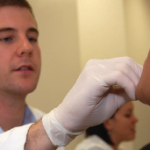Speaking the Language of Health Literacy
Pharmacists Break Down Cultural, Educational Barriers to Empower Patients
 SPEAK SLOWLY AND REPEAT information. Avoid complicated medical terms. Use pictures instead of written descriptions.
SPEAK SLOWLY AND REPEAT information. Avoid complicated medical terms. Use pictures instead of written descriptions.
These are just some of the methods Pamela L. Stamm, Pharm.D., BCPS, CDE, uses to communicate effectively with patients who have low health literacy.
Stamm, a clinical pharmacy specialist who treats patients with diabetes and dyslipidemia at the Central Alabama Veterans Health Care System in Columbus, Georgia, also uses the “teach-back” method, in which patients repeat instructions.
“If patients can put it in their own words, there’s a greater chance they’ll be able to do what I’m asking them to do. My whole goal is to ensure that patients take their medications,” said Stamm.
Stamm’s effort to foster health literacy is just one example of how ASHP members are working to ensure that patients understand what medications they are taking, when and how they should take their medications, and what the medications treat.
“It’s important to remember that not every patient is going to read a pamphlet from the pharmacy, or a graph or table,” said Gina Ryan, Pharm.D., BCPS, CDE, clinical pharmacist at Grady Health System Diabetes Clinic in Atlanta. “If you’re going to give someone a table for blood-sugar values as a reference for adjusting insulin, you can’t just assume the patient understands it.”
A Growing Problem
A reduced capacity to understand medical instructions is a significant, and growing, problem in the U.S., experts say. According to the Institute of Medicine, 90 million people, including elderly patients, minority and immigrant populations, low-income patients, and people with chronic mental or physical health conditions, have difficulty understanding and using health information.

Gina Ryan, Pharm.D., BCPS, CDE , left, clinical pharmacist at Grady Health System Diabetes Clinic counsels a patient, right, at the clinic, as pharmacy student Rhondolyn Jones, takes notes.
The American Medical Association reports that this inability to understand instructions on prescriptiondrug bottles, appointment slips, medical education brochures, a doctor’s directions, and consent forms is “a stronger predictor of a person’s health than age, income, employment status, education level, and race.”1
ASHP and the ASHP Research and Education Foundation are trying to step into the gap, providing tools like “My Medicine List™” on both ASHP’s consumer Web site SafeMedication. com and the Foundation’s Web site.
This free, downloadable tool, which helps patients track the prescription medications, vitamins, ?and other dietary supplements they take daily, was created utilizing health literacy guidelines.
“‘My Medicine List’ is a really great tool to help facilitate that all-important conversation between pharmacists
and their patients,” said ASHP president Lynnae Mahaney, M.B.A., FASHP. “We know from national efforts like Healthy People 20102 that health literacy is a large and growing area of concern, and pharmacists can play a critical role in ensuring patients understand what medications they are taking and how to take them correctly.”
ASHP’s House of Delegates approved a policy in 2002 encouraging health literacy efforts among pharmacists. And it conducts educational programming to help members improve their medication counseling skills related to literacy. At the 2008 Summer Meeting, for example, ASHP offered a session called “Prescription for Confusion: Health Literacy and the Rx Label.” Attendees identified problems related to patients’ misunderstanding of common dosage instructions and learned the keys to drug-label design that ensure patient understanding.
Assessing for Literacy

Steven Chen, Pharm.D., FASHP, a clinical pharmacist at the JWCH Medical Clinic, Los Angeles, checks the blood pressure of a patient.
Pharmacists utilize a variety of tools to assess and respond to low health literacy. For example, a patient who says he can’t see the medication directions because he left his reading glasses at home may be hiding the fact that he can’t read. In this instance, a test such as the Rapid Estimate of Adult Literacy in Medicine (REALM) may be helpful. Pharmacists are also turning to the Ask Me 3 program, which empowers patients to ask and understand the following questions:
1. What is my main problem?
2. What do I need to do?
3. Why is it important for me to do this?
Ryan recommends that patients complete the REALM test during their initial visit. This assessment ensures that patients don’t feel they are being profiled for their reading abilities while giving health care providers insights into the health literacy challenges that may be present.
REALM test results help determine next steps, including using the teach-back method, arranging for relatives to help read instructions once the patient goes home, or informing physicians of the challenges that may be present through medical chart notes.
“I have encountered a significant number of patients who can’t read. It really is a big challenge,” Ryan said. “I’m always trying to figure out how to be effective and efficient. If I’m handing out pamphlets, I don’t want to just check a box to say I gave a person a piece of paper. I want it to work for them.”
But no matter how simple written instructions are, there is nothing better or more effective than face-to-face counseling with pharmacists, said Michael J. Miller, DrPH, who has researched health literacy as an associate professor at the University of Oklahoma College of Pharmacy in Tulsa.“We have a tendency to communicate in the written word. We want to use that as a substitute for personal communication. But there’s no substitute for one-on-one questions,” Dr. Miller said.
ASHP members also use the unique medium of “fotonovelas” to educate patients on health issues such as diabetes. Similar to graphic novels or comic books, fotonovelas tell stories via photos and word bubbles and use limited text.
As a clinical pharmacy specialist at the JWCH Institute Center for Community Health, Los Angeles, Steven Chen, Pharm.D., FASHP, is very familiar with the appeal and effectiveness of fotonovelas among Hispanic patients.
Chen, who is also an assistant professor in the Department of Clinical Pharmacy and Pharmaceutical Economics and Policy, University of Southern California School of Pharmacy in Los Angeles, worked with colleague Mel Baron, Pharm.D., M.P.A., to create a fotonovela about the dangers of untreated diabetes.
Entitled Sweet Temptations, the fotonovela has effectively broken down a number of health literacy barriers among patients, according to Chen. The booklet was funded by a combination of university, industry, nonprofit, and local community pharmacy grants.
“We have to understand that different cultures have different methods that work better,” Chen said. “When you start talking about relatives with the disease, who are struggling with dialysis or facing the prospect of losing a leg, we speak to their values. Personalizing the problem and making it simple is the most important thing we can do for patients.







 If you want to contribute tutorials, news or other stuff please contact us. We pay 150 for each approved article.
If you want to contribute tutorials, news or other stuff please contact us. We pay 150 for each approved article. Consectetur adipisicing elit. Sed do eiusmod tempor incididunt ut labore.
Consectetur adipisicing elit. Sed do eiusmod tempor incididunt ut labore. This site uses valid HTML and CSS. All content Copyright © 2010 Newscast, Inc
This site uses valid HTML and CSS. All content Copyright © 2010 Newscast, Inc If you like what we do, please don't hestitate and subscribe to our
If you like what we do, please don't hestitate and subscribe to our